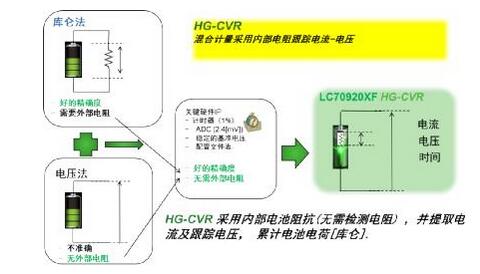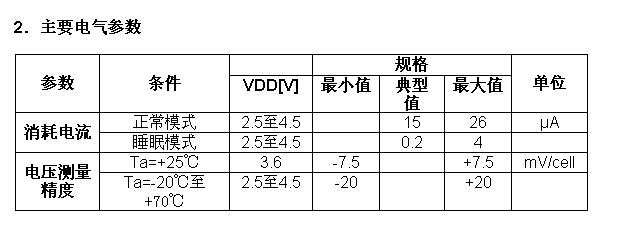Portable electronic products are becoming increasingly close to our lives, and the use of wearable devices has become a new trend in consumption. While the market is growing significantly, how to improve the accuracy of the fuel gauge has become an urgent problem to be solved. A conventional fuel gauge built into a wearable device can provide an accuracy of about ±8%. So if the indicator shows that the remaining charge is 10%, the actual value may be as low as 2%. Users often think that the device can work for a while, but the system suddenly shuts down unexpectedly, losing unsaved key data and work, which brings inconvenience to users. Imagine if this kind of malfunction occurred in the medical environment, it may be life-threatening.
By adding a fuel gauge component to improve the accuracy of the fuel gauge, it is possible to increase the size and weight of the device, and today's consumers need a slimmer, portable/wearable device that integrates more features, so Designers need to consider the use of energy-efficient components.
Traditional electricity metering scheme: Coulomb counting method Coulomb counting method is the most commonly used electricity metering method. It uses high-precision current detecting resistor to continuously monitor the output current of the battery. The current is integrated over time and the result is compared to the known maximum charge to calculate the remaining charge available.

Figure 1: Coulomb counting method
The biggest drawback of the coulomb counting method is that it is very inaccurate, and the possibility of an unexpected shutdown is very high. Since the self-discharge current of the battery does not flow through the external sense resistor, it cannot be detected. Moreover, this self-discharge current is affected by the temperature of the battery, and the self-discharge event causes an increase in the ambient temperature to further affect the accuracy. In addition, accurate measurements can only be taken each time the battery is fully charged, and in fact the battery is not fully charged each time.
Coulomb counting is not only inaccurate, but because it requires the detection of resistance, it leads to increased cost and takes up more PCB space. The detection current flowing through the detection resistor consumes extra battery power, interferes with the performance of the main battery, and increases power loss.
Tracking current based on the internal resistance - LC70920XF fuel gauge IC smart lithium voltage (HG-CVR) method of mixing metered Semiconductor provides an excellent solution to overcome the drawbacks of the coulomb count fuel gauge, and to solve the above design challenges: based Precision on-board conversion (ADC) technology for on-board fuel gauges, and built-in error correction and temperature compensation in the fuel gauge. Combined with low power operation and high precision metering, it ensures longer battery life by reducing wear and tear. In addition, no external sense resistor means no power loss and saves valuable PCB space.
Based on a unique metrology method called HG-CVR, the LC70920XF measures the relative charge state (RSOC) of a battery with an error of ±2.8%, even under relatively unstable conditions, including temperature, aging, loading, and self-discharge.
A sophisticated reference voltage is critical to accurate voltage measurements. The LC70920XF has an accurate internal reference voltage circuit, which is unaffected by temperature, and stores a reference table in its memory, which includes data on the voltage/capacity, resistance/capacity, and resistance/temperature functions of the battery.
The HG-CVR method measures battery voltage, temperature, internal resistance, and open circuit voltage (OCV). OCV is the battery voltage of no load current. The measured battery voltage is divided into OCV and voltage as a function of load current. The varying voltage is generated by the load current and internal resistance. Then the current value is determined by the following formula:
V(VARIED) = V(MEASURED)-OCV
I=V(VARIED)/R(INTERNAL)
Where V(VARIED) is the voltage that varies with the load current, V(MEAUSRED) is the measured voltage, and R(INTERNAL) is the internal resistance of the battery. The internal resistance is affected by factors such as remaining power, load current, and temperature. The HG-CVR method extracts the charge (Coulomb) after monitoring the voltage and calculates it using the resistance profile and the voltage profile.
The remaining battery power is then calculated by continuously comparing the measured voltage and temperature to the values ​​in the reference table. When the battery voltage is lower, the readings are more frequent to ensure an accurate prediction when the remaining battery life becomes shorter.
Unlike other charge measurement methods, the HG-CVR method allows for battery self-discharge events without the need to fully charge the device's battery for calibration. Even if the battery is only charged to 50%, the remaining battery life can be accurately calculated.

Figure 2: ON Semiconductor's patented HG-CVR method
How to identify aging?
By repeating the discharge/charge, the internal resistance of the battery will gradually increase and the full charge capacity (FCC) will decrease. In the coulomb counting method, the RSOC is usually calculated using the FCC and the remaining capacity (RM).
RSOC = RM/FCC × 100%
Coulomb counting must measure the reduced FCC in advance through the learning cycle. The HG-CVR measures the RSOC of the battery without the need for a learning cycle. The internal battery resistance used to calculate the current is highly correlated with the FCC. This correlation depends on the chemical function of the battery. The RSOC reported using this correlation is not affected by aging.
One problem with the error auto-convergence coulomb counting method is that the error accumulates over time, and the fuel gauge using the coulomb counting method must find an opportunity to correct it. The LC70920XF with HG-CVR has the function of RSOC error convergence, and the error converges continuously from the estimation of the open circuit voltage. Moreover, the Coulomb counting method cannot detect accurate residual changes because the self-discharge current is too small, but the HG-CVR method can accurately detect the voltage information.
Easy and fast installation In general, it is necessary for the fuel gauge to obtain multiple parameters, which usually consumes a lot of resources and additional development time. A unique feature of the LC70920XF is that multiple profiles are built into it, so the amount of parameters to be prepared at the beginning of the battery measurement is very small, simplifying the design and speeding up the installation.
Power-on Reset/Battery Insertion Detection When the LC70920XF detects a battery insertion, it begins an automatic power-on reset. Once the battery voltage exceeds the reset release voltage (VRR), it will release the reset state and will complete initialization to enter sleep mode or operating mode. All registers are initialized after a power-on reset. If the battery voltage is much lower than the VRR during operation, the LC70920XF also automatically performs a system reset.
The low-power HG-CVR measures voltage and temperature for a preset period of time without the need for continuous operation of the monitoring circuit, which allows the fuel gauge circuit to put itself into a power-saving sleep mode between measurement intervals without the need to sense resistance and reduce active power. Consumption.
The fuel gauge using the HG-CVR method reduces the number of components required and reduces power consumption. Taking the LC709203F as an example, it has four times less external component count than competing solutions, allowing design engineers to eliminate external current-sense resistors and reduce the printed circuit board size by approximately 77.5% in a compact package measuring 1.76mm x 1.6mm. It is about 45% smaller than the competitive solution, which not only reduces BOM cost and design time, but also improves reliability. Moreover, due to the lower number of external components required, the LC709203F significantly reduces total power consumption, with an operating current of 15 uA, which is about 1/10 of the competing component 118 uA. In active mode, power consumption is reduced by 87%, and in sleep mode, power consumption is reduced by 60%.
Temperature compensated lithium batteries are susceptible to environmental conditions and changes in ambient temperature. Especially as the temperature drops below 0 °C, the battery resistance changes, causing the battery voltage drop to increase as the discharge current flows. ON Semiconductor's smart lithium battery fuel gauge LC70920XF has a unique calibration algorithm built in to ensure that the error at all battery voltages is kept within 2.8% over a wide range of ambient temperatures.
Intelligent lithium battery fuel gauge LC709203F overview 1. Function · Adopt HG-CVR algorithm technology: no need for external detection resistor, measure battery RSOC error as low as 2.8%, adjust battery parasitic resistance, simplify design, provide low power consumption, provide precise voltage measurement, and have precise timer Alerts at low RSOC or low voltage • Provides temperature compensation: temperature is measured via I2C input or directly by thermistor, this temperature compensation helps ensure that the fuel gauge maintains error at all battery voltages over a wide range of ambient temperatures Within 2.8%.
·I2C interface supports up to 400 kHz frequency

3. Module diagram and pin assignment LC709203F can be packaged in WDFN8 and WLCSP9. The block diagram is shown in Figure 3. among them,
TEST pin: Connect to VSS
VSS pin: Connect to the battery negative VDD pin: Connect to the battery positive ALMIB pin: The low output (open drain) indicates the alarm, the pull-up must be done externally, the alarm condition is specified by the register, and the pin is connected when not in use. To VSS. If the remaining charge of the battery drops below the set value or below the set voltage, the ALARMB output TSW pin is pulled through the open-drain internal FET: thermistor power supply output. This pin is high when the temperature value is being read. The TSW resistor value (for pull-up thermistor) must be the same as the thermistor value. TSENSE pin: Thermistor input. If you connect this pin to the thermistor, insert a 100 Ω resistor for ESD
SDA pin: I2C data pin (open drain). The pull-up must be done externally on the SCL pin: the I2C clock pin (open drain). Pull-up must be done externally

It should be noted that the TSW and TSENSE pins must be disconnected when not in use.
4. Notes on electrical functions and wiring layout 1). Since the I2C address is fixed, make sure that other components do not use the same address. 2). The initialization time of the component from the power-on is less than 80 ms. 3). If initialized by I2C (Initial RSOC), then start reading the battery value after 2 ms 4). If the power is applied to VDD and VSS, the battery value will remain stable regardless of the state of the enable/disable register 5). Connect as close as possible to the IC Capacitance between VDD and VSS (1 μF)
6). When not using the alarm function, simply connect the alarm terminal to the VSS. No pull-up resistors are needed. The wearable device needs more accurate, lower power consumption and smaller size. The intelligent lithium battery of ON Semiconductor The fuel gauge LC70920XF overcomes the drawbacks of the traditional Coulomb counter fuel gauge, adopts the patented HG-CVR method, built-in error correction and temperature compensation, and more accurately measures the remaining battery power, so that wearable device users can accurately know the remaining battery life at any time. No longer troubled by an unexpected system shutdown. Since the scheme eliminates the detection resistance, the number of external components is reduced, and the power consumption is the lowest in the industry, providing users with more accurate, smaller size, and higher energy efficiency.
Featuring level VI energy efficiency and meet international safety standards, the external ac to dc power adapter accepts universal AC input voltage ranging from 100V to 240V and provides 3 years warranty. These wall plug series class 6 power adapters includes safety protections for over voltage, over current and short circuit; provides US UK EU AU KR AC Plugs optionals for America, Canada, United Kingdom, Europe, Austraila and South Korea.
5V Dc Adapter,Travel Plug Adapter,Ul Power Adapter,Wall Plug Power Supply,Plug Adapter 230V 24V
Shenzhenshi Zhenhuan Electronic Co Ltd , https://www.szzhpower.com